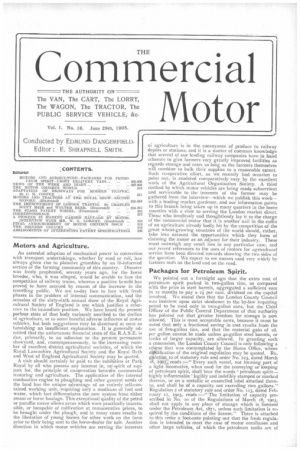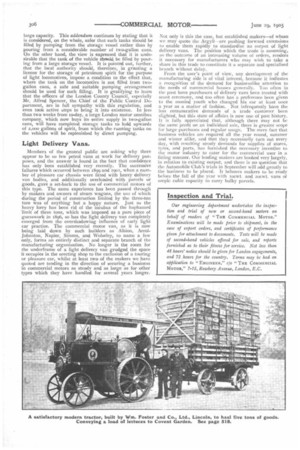Motors and Agriculture.
Page 1

Page 2

If you've noticed an error in this article please click here to report it so we can fix it.
An extended adoption of mechanical power in connection with transport undertakings, whether by road or rail, has always given rise to plaintive grumbles by an ill-infca-rned section of the farming community of this country. Disaster was freely prophesied, seventy years ago, for the horse breeder, who, it was alleged, would be unable to face the competition of railway trains, whereas a positive benefit has proved to have accrued by reason of the increase in the travelling public. We are to-day face to face with fresh phases in the problem of internal communication, and the occasion of the sixty-sixth annual show of the Royal Agricultural Society of England is one which justifies a reference to the immediate position. We have heard the present parlous state of that body variously ascribed to the decline of agriculture, or to some baneful adverse influence of motor vehicles, but both suggestions may be dismissed at once as furnishing an insufficient explanation. It is generally admitted that the unfortunate financial state of the R.A.S.E. is due, primarily, to an adhesion to the present permanent showyard, and, contemporaneously, to the increasing number of excellent district agricultural societies, of which the Royal Lancashire Agricultural Society and the Royal Bath and West of England Agricultural Society may be quoted. A visit should certainly be paid to the exhibition at Park Royal by all who possess any interest in, ort spirit of support for, the principle of co-operation between commercial motoring and agriculture. The application of the internal combustion engine to ploughing and other general needs of the land has the unique advantage of an entirely self-contained working unit, requiring only a modicum of fuel and water, which fact differentiates the new system front either steam or horse haulage. This exceptional quality of the petrol or paraffin motor allows areas which were practically inaccessible, or incapable of cultivation at remunerative prices, to be brought under the plough, and in many cases results in the liberation of young horses for other work on the farm prior to their being sent to the horse-dealer for sale. Another direction in which motor vehicles are serving the interests oi agriculture is in the conveyance of produce to railway depdts or stations, and it is a matter of common knowledge that several of our leading railway companies have in hand hcheines to give farmers very greatly improved facilities as regards storage and rates so long as the farmers themselves will combine to bulk their supplies to a reasonable extent. Such co-operative effort, as we recently had occasion to point out, is rendered comparatively easy by the excellent work of the Agricultural Organisation Society. A third method by which motor vehicles are being made subservient and serviceable to the interests of the farmer may be gathered from the interview—which we publish this week— with a leading market gardener, and our information points to this branch being taken up in many quarters in the home counties with a view to serving the London market direct. Those who heedlessly and thoughtlessly lay it to the charge of the commercial motor that it is another nail in the coffin of an agriculture already badly hit by the competition of the great wheat-growing countries of the world should, rather, take into account the opportunities which they have of claiming the motor as an adjunct fur their industry. These must outweigh any small loss in any particular case, and our recent references to the uses of motors for agricultural service have been directed towards showing the two sides of the question. We expect to see motors used very widely by farmers both on the land and on the road.
Packages for Petroleum Spirit.
We pointed out a fortnight ago that the extra cost of petroleum spirit packed in two-gallon tins, as compared with the price in steel barrels, aggregated a sufficient sum in 12 months to pay a 24 per cent, dividend on the capital involved. We stated then that the London County Council was insistent upon strict obedience to the by-law requiring petrol to be used only in two-gallon cans, but the Chief Officer of the Public Control Department of that authority has pointed out that greater freedom for storage is now allowed. This is most acceptable news, because it must be noted that only a fractional saving in cost results from the use of five-gallon tins, and that the material gain of id. per gallon cannot be made unless 40-gallon steel barrels, or tanks of larger capacity, are allowed. In granting such a concession, the London County Council is only following a course that was contemplated by the Home Office, whose rrOlification of the original regulation may be quoted. ReOlation to of statutory rule and order No. 225, dated March i8, 1903; reads :=" Every such vessel, not forming part of a light locomotive, when used for the conveying or keeping of petroleum spirit, shall bear the words 'petroleum spirit-highly inflammable 'legibly and indelibly stamped or marked thereon, or on a metallic or enamelled label attached thereto, and shall be of a capacity not exceeding two gallons." Regulation 2 of statutory rule and order No. 113, dated February 11, 1905, reads :—" The limitation of capacity prescribed in No. to of the Regulations of March 18, 19(33, shall not apply in any place of storage which is licensed under the Petroleum Act, 1871, unless such limitation is required by the conditions of the license." There is attached to this order a foot-note pointing out that the fresh regulation is intended to meet the case of motor omnibuses and other large vehicles, of which the petroleum tanks are of large capacity. This addendum continues by stating that it is considered, on the whole, safer that such tanks should be filled by pumping from the storage vessel rather than by pouring from a considerable number of two-gallon cans. On the other hand, the view is expressed that it is undesirable that the tank of the vehicle should be filled by pouring from a large storage vessel. It is pointed out, further, that the local authority should, therefore, in granting a license for the storage of petroleum spirit for the purpose of light locomotives, impose a condition to the effect that, where the tank on the locomotive is not filled from twogallon cans, a safe and suitable pumping arrangement should be used for such filling. It is gratifying to learn that the officers of the London County Council, especially Mr. Alfred Spencer, the Chief of the Public Control Department, are in full sympathy with this regulation, and even took active steps to bring it into existence. In less than two weeks from to-day, a large London motor omnibus company, which now buys its entire supply in two-gallon cans, will have completed storage tanks to hold upwards of 2,000 gallons of spirit, from which the running tanks on the vehicles will be replenished by direct pumping.
Light Delivery Vans.
Members of the general public are asking why there appear to be so few petrol vans at work for delivery purposes, and the answer is found in the fact that confidence has only been established very recently. The successive failures which occurred between 1899 and toot, when a number of pleasure car chassis were fitted with heavy delivery van bodies, and additionally overloaded with parcels or goods, gave a set-back to the use of commercial motors of this type. The same experience has been passed through by makers and owners of steam wagons, the use of which during the period of construction limited by the three-ton tare was of anything but a happy nature. Just as the heavy lorry has been rid of the incubus of the haphazard limit of three tons, which was imposed as a pure piece of guesswork in 1896, so has the light delivery van completely emerged from the overshadowing influence of early light car practice. The commercial motor van, as it is now being laid down by such builders as Albion, ArrolJohnston, Napier, Simms, and Wolseley, to name a few only, forms an entirely distinct and separate branch of the manufacturing organisation. No longer is the room for the underframe of a light delivery van grudged the space it occupies in the erecting shop to the exclusion of a touring or pleasure car, whilst at least two of the makers we have quoted are tending in the direction of securing a business in commercial motors as steady and as large as for other types which they have handled for several years longer. Not only is this the case, but established makers—of whom we may quote the Argyllare pushing forward extensions to enable them rapidly to standardise an output of light delivery vans. The position which the trade is assuming, as the outcome of an increasing volume of orders, renders it necessary for manufacturers who may wish to take a share in this trade to constitute it a separate and specialised branch without delay.
From the user's point of view, any development of the manufacturing side is of vital interest, because it indicates a recognition of the demand for businesslike attention to the needs of commercial houses generally. 1 no often in the past have purchasers of delivery vans been treated with scant ceremony, and too often has a preference been given ta the monied youth who changed his car at least once a year as a matter of fashion, Not infrequently have the less remunerative demands of a trade customer been slighted, but this state of affairs is now one of past history. It is fully appreciated that, although there may not be the same profit on an individual sale, there is greater scope for large purchases and regular usage. The mere fact that business vehicles are required all the year round, summer and winter alike, and that they necessarily turn out every day, with resulting steady demands for supplies of stores, tyres, and parts, has furnished the necessary incentive to the motor industry to cater for ihe commercial user in a fitting manner. Our leading makers are booked very largely, in relation to existing output, and there is no question that the Automobile Club's trials in September will add greatly to the business to be placed. It behoves makers to be ready before the fall of the year with mewt, and 2ocwt. vans of ample cubic capacity to carry bulky parcels,
















